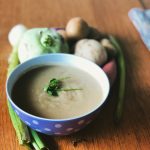When I was young, on the way home from school we would stop at the ‘tuck shop’ and buy a penny’s worth of ‘gumballs’ – yes that was their name. They tasted like aniseed, but with toffee in the middle, underneath a coating of sugary crunch. What I savoured as a child, turned into fennel as an adult!
I am not recommending you eat any, plays havoc with the teeth! But you must try fennel, a wonderful bulbous vegetable that reminds me of schooldays. Very versatile but I guess some people would say it is an acquired taste. It’s quite widely grown, as long as the regions are temperate. I think it looks like a weird sort of onion that is sprouting (as it does when an onion sits in your veg basket for too long), but tastes nothing like an onion. But boy, it sure packs a flavour however you decide to eat it.
How to cut up and cook fennel
It does make a difference, depending on what recipe you are making. The one thing you must do first is remove the brown bits where you can. Then, just tear off the outer leaves and fronds. Put to one side for use after you have decided if you are eating it raw or cooked.
If you are eating it raw in a salad (mighty tasty, with a hint of celery, radish and pepper as its base flavour) followed on the palate by a kind of licorice hint. You must slice it very thinly when raw, as it can be quite tough if its not cooked. Lovely and crunchy though…
Braising is a lovely way to eat fennel, it softens and modifies the flavour a little, leaving it tasting more mellow and slightly sweet.
You can also roast or grill it, pan fry it with pork and orange (that’s really yummy) or when you are roasting something like a chicken, slice it thickly and place under the bird, then serve it with the chicken. So many things you can do with it. Use in a slaw, with antipasti, or cook and toss through a pasta dish. It also goes brilliantly with fish, particularly sea bass.
Whoops, and don’t forget soups, of course, and if you are a ‘pickler’, fennel is your guy for the job.
 |
Looking for a soup containing fennel? Try this vegan potato and fennel soup recipe. |
What to look for in a healthy fennel bulb
Avoid any bulbs that look bruised or brown in places. Leaves should be firm and the fronds not ‘floppy’. They are usually sold unwrapped, so you can have a jolly good feel and a sniff of it before buying. Excluding imports, you usually find fennel between Autumn and Spring, perfect timing for soups! Best to purchase at farmers markets as they are more likely to be fresh.
If you add fennel seeds to your aromatics in the storecupboard, always make sure the lid is air tight, or at least as tight as you can get it. It will last up to a year, but best up to 6 months, after which it may lose its aroma.
Other uses for fennel
This wonderful vegetable has many uses, particularly when it comes to Asian cuisine and culture. The Chinese make wonderful sausages with fennel seeds and mustard seeds, and it is already used in the powder form of Chinese Five Spice, used in a lot of their dishes.
Fennel seeds and fronds
Fennel seeds are omnipresent in curries too, and also recommended in Ayurveda medicine, or drunk as a herbal tea. After dinner, many Indians use fennel seeds to clean their teeth and palate (prefer toothbrushes myself!). I understand it also sweetens the breath, so goodbye garlic odour!
When it comes to fronds, they can be chopped up into a salad, sauce or used to stuff into a whole baked fish with lemon and finely chopped onions. Some chefs use it only to garnish a plate (waste of good fronds!). If you want to use fronds, keep them in the crisping drawer of your fridge, as once exposed to air, they will deteriorate, so use them quickly.
Don’t forget to look at our recipe section, there are lots of recipes using fennel and they are ‘Simply Souperlicious-Delicious’!


Want to comment?
Sign in or Register